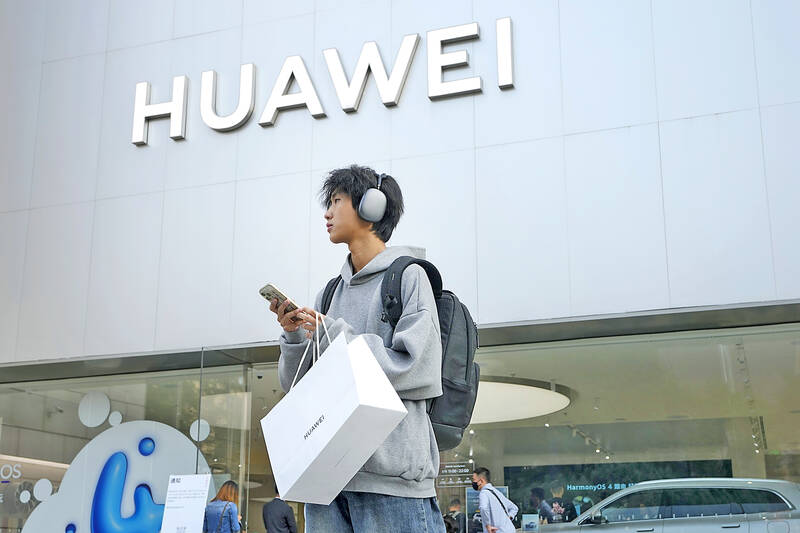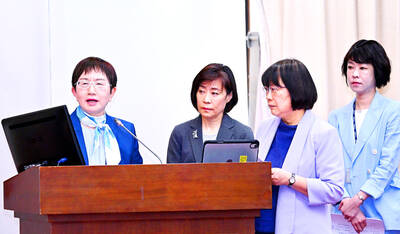The US might not be able to stop Chinese firms, including Semiconductor Manufacturing International Corp (SMIC, 中芯) and Huawei Technologies Co (華為), from making progress in chip technology, one of the semiconductor industry’s leading figures said this week.
SMIC and Huawei, which stunned Washington by unveiling a made-in-China phone processor, can use existing older machines to make even more sophisticated silicon, former Taiwan Semiconductor Manufacturing Co (TSMC, 台積電) vice president Lin Burn-jeng (林本堅) said.
SMIC should be able to advance to 5-nanometer technology with ASML Holding NV machines that it already operates, said Lin, who at TSMC championed the lithography technology that transformed chipmaking.

Photo: AP
Huawei electrified the chip industry when it unveiled a 7-nanometer processor made by SMIC in the Mate 60 Pro, triggering celebrations in China and accusations in the US that a campaign to contain the country’s tech ascent had failed.
Yangtze Memory Technologies Co (長江存儲) is also producing some of the most advanced memory chips in the industry.
The administration of US President Joe Biden this month tightened curbs to close loopholes through which China might be accessing advanced US equipment, marking a new phase in a struggle to influence technologies crucial to the economic and political balance.
Yet that might not stop China’s technological ascent, said Lin, who is highly regarded in the industry for being the first person to propose immersion lithography, the technology that ASML’s core products rely on.
SMIC used ASML’s immersion lithography machines to make the 7-nanometer chip for Huawei, Lin said.
Beyond trying to reach the 5-nanometer milestone, it is likely that China would experiment with new materials or advanced chip packaging to make more powerful semiconductors, he said.
“It is just not possible for the US to completely prevent China from improving its chip technology,” Lin said in an interview at National Tsing Hua University in Hsinchu City, where he serves as dean of the semiconductor research college.
That echoed comments from Arm Holdings PLC chief executive officer Rene Haas earlier this month.
“What the US really should do is to focus on maintaining its chip design leadership instead of trying to limit China’s progress, which is futile, as China is adopting a whole-nation strategy to boost its chip industry, and hurting the global economy,” Lin said.
The US might have inadvertently granted Shanghai-based SMIC a golden opportunity, he added.
In 2020, Washington effectively banned TSMC — supplier of the world’s most advanced silicon to Apple Inc and Nvidia Corp — from doing business with Huawei.
That is when SMIC stepped up to inherit the massive orders that helped it to improve its manufacturing technique, Lin said.
A debate is now raging in the US and beyond about whether Washington and its allies should step up their Chinese containment campaign.
US Secretary of Commerce Gina Raimondo has said Washington does not have evidence that China can make advanced chips “at scale.”
US Under-Secretary of Commerce for Industry and Security Alan Estevez said it is “absolutely” a concern for Washington that China could use 7-nanometer technology — or better — in military applications.

‘SWASTICAR’: Tesla CEO Elon Musk’s close association with Donald Trump has prompted opponents to brand him a ‘Nazi’ and resulted in a dramatic drop in sales Demonstrators descended on Tesla Inc dealerships across the US, and in Europe and Canada on Saturday to protest company chief Elon Musk, who has amassed extraordinary power as a top adviser to US President Donald Trump. Waving signs with messages such as “Musk is stealing our money” and “Reclaim our country,” the protests largely took place peacefully following fiery episodes of vandalism on Tesla vehicles, dealerships and other facilities in recent weeks that US officials have denounced as terrorism. Hundreds rallied on Saturday outside the Tesla dealership in Manhattan. Some blasted Musk, the world’s richest man, while others demanded the shuttering of his

Taiwan’s official purchasing managers’ index (PMI) last month rose 0.2 percentage points to 54.2, in a second consecutive month of expansion, thanks to front-loading demand intended to avoid potential US tariff hikes, the Chung-Hua Institution for Economic Research (CIER, 中華經濟研究院) said yesterday. While short-term demand appeared robust, uncertainties rose due to US President Donald Trump’s unpredictable trade policy, CIER president Lien Hsien-ming (連賢明) told a news conference in Taipei. Taiwan’s economy this year would be characterized by high-level fluctuations and the volatility would be wilder than most expect, Lien said Demand for electronics, particularly semiconductors, continues to benefit from US technology giants’ effort

ADVERSARIES: The new list includes 11 entities in China and one in Taiwan, which is a local branch of Chinese cloud computing firm Inspur Group The US added dozens of entities to a trade blacklist on Tuesday, the US Department of Commerce said, in part to disrupt Beijing’s artificial intelligence (AI) and advanced computing capabilities. The action affects 80 entities from countries including China, the United Arab Emirates and Iran, with the commerce department citing their “activities contrary to US national security and foreign policy.” Those added to the “entity list” are restricted from obtaining US items and technologies without government authorization. “We will not allow adversaries to exploit American technology to bolster their own militaries and threaten American lives,” US Secretary of Commerce Howard Lutnick said. The entities

Minister of Finance Chuang Tsui-yun (莊翠雲) yesterday told lawmakers that she “would not speculate,” but a “response plan” has been prepared in case Taiwan is targeted by US President Donald Trump’s reciprocal tariffs, which are to be announced on Wednesday next week. The Trump administration, including US Secretary of the Treasury Scott Bessent, has said that much of the proposed reciprocal tariffs would focus on the 15 countries that have the highest trade surpluses with the US. Bessent has referred to those countries as the “dirty 15,” but has not named them. Last year, Taiwan’s US$73.9 billion trade surplus with the US